Skin Tag Removal
What are skin tags?
Skin tags are small, soft, flesh-colored growths that typically appear in areas where the skin folds or experiences friction, such as the neck, underarms, eyelids, or groin. They are benign (non-cancerous) and generally painless but may become irritated or unsightly.
How are skin tags removed?
Skin tags can be removed through several safe and effective methods, including cryotherapy (freezing), electrocautery (burning), excision (cutting), or laser treatment. The choice of method depends on the size, location, and number of skin tags.
Is the procedure painful?
Most procedures are quick and involve minimal discomfort. A local anesthetic may be used to ensure the process is as comfortable as possible.
Is there any downtime?
There is little to no downtime. Most people can return to normal activities immediately, although mild redness or scabbing at the removal site may occur and usually resolves within a few days.
Will the skin tag grow back?
Once a skin tag is removed, it typically does not grow back in the same spot, though new skin tags can form in other areas over time.





